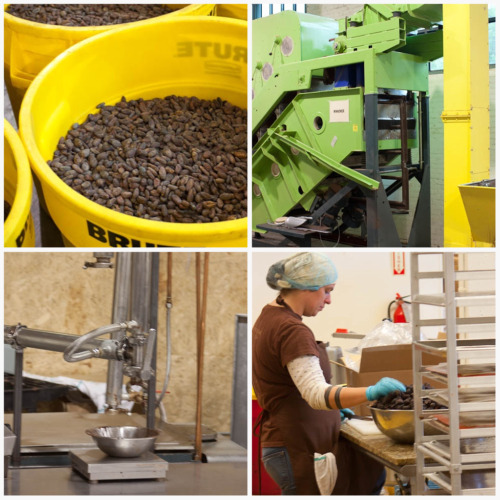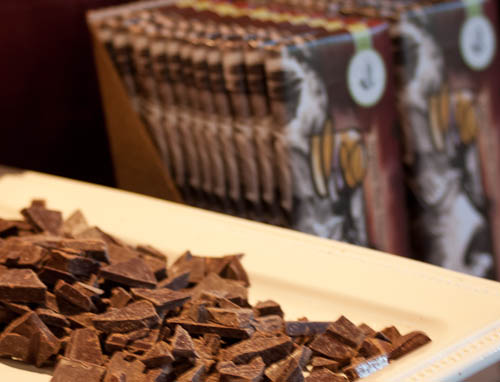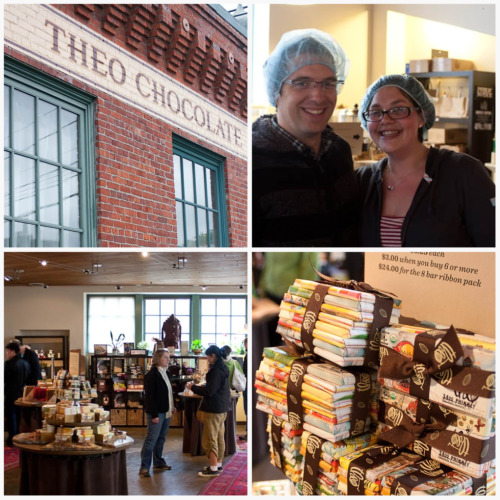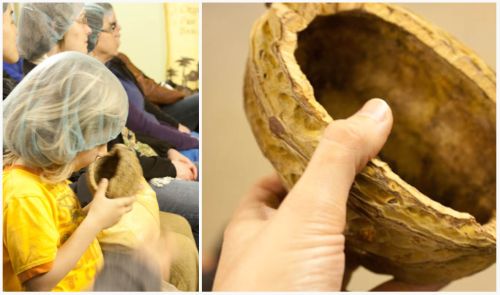
Roasted beans, the Winnower machine, the tempering machine, quality control
In the factory itself, there are a number of machines and steps that are involved in creating the final product. They use a European roaster (there are less than 100 of these left in the world) which drives off moisture. Our tour guide explained that they do a partial roast to begin with and then send the beans into the "Winnower" machine where they are slammed against a steel plate to allow for the husks to separate, and are then moved through different meshes and through an air stream that blows the husk away from the recently smashed nibs. Then the cleaned nibs go back in the roaster to further develop the flavor. After this, off to the Ball Mill which whirls the beans at high speed so that they can be broken down and eventually turned into chocolate liqueur. They add evaporated cane juice, and 6500 pounds of chocolate goes into one holding tank where it is eventually taken to their tempering machines and out into individual molds.
Flavors of Theo Chocolate we Sampled:

Samples, samples, and more samples
I'm not sure that most people are used to describing the nuances of chocolate in the same way that we often do with wine or even with coffee. But our tour guide encouraged us to mention the first word that came to our minds when we sampled different bars. People began to loosen up after a few minutes and really explore their palates and their personal preferences. Here is a sampling of what we tried:
- Lime Coriander Confection: I loved this little square. It had a subtle, spring citrus flavor and just a hint of coriander. I was surprised to learn each confection and caramel is still hand-decorated.
- Pink Salted Vanilla Caramel: My mom bought some of these to take home. I can't honestly say that the pink salt adds any different flavor profile than regular salt, but they sure are pretty.
- Lemon Verbena Confection: Spring time in one bite. Vibrant, bright lemon flavor enrobed in dark chocolate.
- Milk Chocolate Chai Bar: While I much prefer dark to milk chocolate, I ended up falling in love with this bar and bringing one home. At Theo, their milk chocolate has at least 40% cocoa, so it still seems very rich and complex. I loved the warm spice flavor profile.
- Dark Chocolate Toasted Coconut Bar: And I bought two of these. Apparently they are seasonal so I was concerned they may go away forever. If you like coconut, try and get your hands on one.
- Dark Chocolate Cherry Almond: A really classic combination of organic cherries and rich dark chocolate studded generously with almonds.
- 91% Dark Chocolate Bar: This blew me away. I've tried 95% chocolate before and it just screamed baking chocolate--bitter, leaving your mouth with a dry, unpleasant taste. But Theo's 91% bar was not at all bitter (although not all that sweet either). The perfect bar for a dark chocolate purist.
- Nib Brittle (70%): I learned on the tour that people either love or hate cocoa nibs. I happen to love them, but by the looks on the faces of many of the folks around me, that's not always the case. This bar has organic, roasted nibs enrobed in a crunchy, slightly sweet brittle.
The Future of Chocolate in the U.S.
The tour closed with some interesting information that I wasn't aware of. Chocolate production in the U.S. is a really new endeavor--spanning only the last 250 years. And, like anything, the standards are constantly changing in regards to the percentage of cocoa required, fillers allowed etc. I was shocked to learn that currently commercial products only have to be 10% cocoa to call themselves chocolate. Yikes. What comprises the rest? Check out your average grocery store aisle and see if you can locate the chocolate chips often labeled "chocolate baking chips"--they're mostly milk solids and sugar. So Theo's whole point is that life is too short to eat bad quality chocolate and, in remaining firm with such high standards, they'll hopefully help shape the future landscape of chocolate standards and regulation. On their website they note:
At Theo, we believe there is no luxury in products that benefit us today, while jeopardizing future generations ability to meet their needs. When you taste our chocolate you will experience our passion and integrity in every luscious bite.



